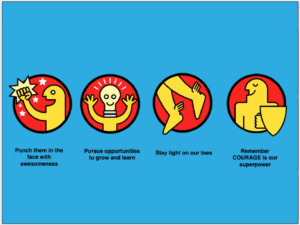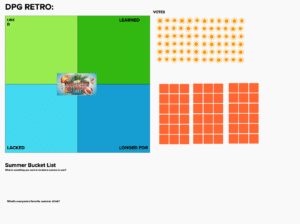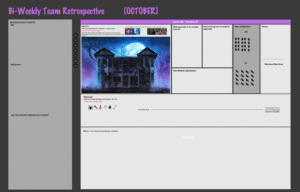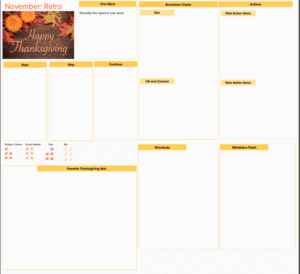Retros, Popcorn and being Frozen

Learning from Nestlé Purina ECD Teresa Sausville at our latest In-House Life session
Our guest for the final In-House Life session of the year was Teresa Sausville, ECD of Checkmark, Nestlé Purina’s in-house agency based in St Louis, Missouri.
Checkmark was established 30 years ago and now has a staff of 150 – with a creative department of 70 full-time and 20 freelancers – working across Purina’s dog and cat food brands. Teresa joined 10 years ago, having started as a copywriter and subsequently a VP at external agencies.
During the session, she shared a host of tips and approaches that she applies in her work. We’ve picked out a few to share:
Setting goals
As Teresa said, when you’re in an in-house agency, you’re inundated with a lot of corporate speak and corporate goals. Those are important, but creatives may not feel a lot of buy-in to goals that seem beyond their ability to affect. Together with her creative leadership team, Teresa devised four goals for Checkmark which are derived from the wider business strategy but which make her teams feel like they can affect them in their daily work. The four goals are: Punch them in the face with awesomeness; pursue opportunities to grow and learn; stay light on our toes; remember, courage is our superpower.
They are communicated with fun icons and informal language and are kept alive with initiatives asking people how they are striving in fun contexts.

Fail Forward
Initiated by its CMO, Checkmark has instituted a Fail Forward culture, which recognises the importance of embracing failure and learning from mistakes. Colleagues are encouraged to share their failures with a PTO day offered as the prize for ‘best failure’. She believes that acknowledging and learning from failure better positions Checkmark as a partner to colleagues.
Courage and Modelling Behaviours
Courage, Teresa reminded us, can be manifest in a lot of little things, and it starts with the leadership. If people can see leaders, for example, pushing back on a brief, or standing up against feedback that doesn’t make sense, those actions become contagious and everyone starts to feel more confident in standing up for their work and beliefs.
Better Briefing
Checkmark has instituted briefing training for marketing colleagues in order to address some common problems, including trying to include too many messages or goals in the same brief. Key to the training is asking colleagues to work toward getting to a single message, or a ‘single source of truth’ for each brief, asking awkward questions along the way, such as ‘why do we need this product?’ Or ‘why does it exist?’.
Briefing training, she told us, also helps smooth the feedback process. Feedback can be challenged over whether it goes back to the agreed single source of truth. Is the feedback making the idea better or just different? How will this change better enable us to do the thing we agreed we were going to do?
Frozen and “a ridiculous level of ‘no’”
Checkmark has instituted the idea of a project being ‘Frozen’ ie at a certain point, no more feedback and no more changes are allowed. Allied to this, account managers are empowered to deploy what she calls “a ridiculous level of ‘no’”. In other words, account managers adhere rigidly to the agreed process and do not allow marketing colleagues to bypass or break even the smallest rules. Even on the silliest things, she says, they try to be totally consistent so that everyone knows where they stand.

Popcorn, retros and taking about the work
Checkmark has various formats for ensuring that the work is discussed and critiqued. Quarterly Popcorn sessions help celebrate the small successes of good creative work, as well as taking positives out of failures. Instead of 20 minute case studies where attention wavers, in these sessions you have one slide and two minutes to share a success, a piece of good work, or a moment of courage. By the end of the session, Teresa says, everyone in the room has around 20 to 30 examples of awesome things that they can use as inspiration.


Wash-up meetings or Crits may be dreaded by teams if they feel they are going to be about apportioning blame.
Checkmark borrows an idea from the Agile process to make them fun, positive experiences. It stages regular Retros using themed Miro boards (see examples above and below). Teams are asked to share what they liked, learned, lacked and longed for during that period of time by placing icons on the board. They talk about what they are proud of, as well as about things that broke down, or issues to solve. And, importantly, there is a rule that if you have an issue but you don’t bring it up in the Retro and you don’t help solve it in the Retro, you can’t complain about it later.
Our thanks to Teresa and to our partners Adobe Workfront. Look out for news of our 2022 IHALC events coming soon.
